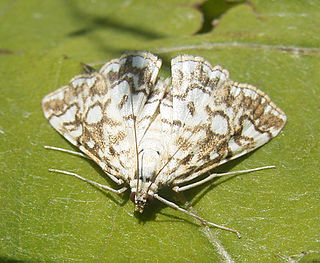Related Research Articles

Chionodes is a genus of moths of the family Gelechiidae. It is distributed throughout much of the world. The larvae of many species use the Douglas fir as a host plant.

Pyraustinae is a large subfamily of the lepidopteran family Crambidae, the crambid snout moths. It currently includes over 1,400 species; most of them tropical but some found in temperate regions including both North America and Europe.

Spilomelinae is a very species-rich subfamily of the lepidopteran family Crambidae, the crambid snout moths. With 4,132 described species in 340 genera worldwide, it is the most speciose group among pyraloids.

The Lecithoceridae, or long-horned moths, are a family of small moths described by Simon Le Marchand in 1947. Although lecithocerids are found throughout the world, the great majority are found in the Indomalayan realm and the southern part of the Palaearctic realm.

Crambinae is a large subfamily of the lepidopteran family Crambidae, the crambid snout moths. It currently includes over 1,800 species worldwide. The larvae are root feeders or stem borers, mostly on grasses. A few species are pests of sod grasses, maize, sugar cane, rice, and other Poaceae. The monophyly of this group is supported by the structure of the tympanal organs and the phallus attached medially to the juxta, as well as genetic analyses.

Amata is a genus of tiger moths in the family Erebidae. The genus was erected by Johan Christian Fabricius in 1807.

Ceryx is a genus of moths in the family Erebidae. It was described by Hans Daniel Johan Wallengren in 1863.

Kiwaia is a genus of moths in the family Gelechiidae. Two subgenera are currently recognised, (i) the nominotypical subgenus with 25 species from New Zealand, and (ii) subgenus Empista with 4 species from the Palaearctic Region.

Bradina is a genus of moths of the family Crambidae.
Piletocera is a genus of moths of the family Crambidae. The genus was first described by Julius Lederer in 1863.
Timyra is a genus of moths in the family Lecithoceridae.

Macrobathra is a genus of moths in the family Cosmopterigidae. Most species are endemic to Australia.

Macarostola is a genus of moths in the family Gracillariidae. The genus was erected by Edward Meyrick in 1907.

Acentropinae is a fairly small subfamily of the lepidopteran family Crambidae, the crambid snout moths. Species of this subfamily are exclusively found in wetlands and aquatic habitats.
Ceryx evar is a moth of the subfamily Arctiinae. It was described by Pagenstecher in 1886. It is found on Ambon Island, Aru and the Key Islands.
Apatetrinae is a subfamily of moths in the family Gelechiidae. The subfamily was described by Edward Meyrick in 1947.

Margaroniini is a tribe of the species-rich subfamily Spilomelinae in the pyraloid moth family Crambidae. The tribe was erected by Charles Swinhoe and Everard Charles Cotes in 1889.
References
- ↑ Savela, Markku (21 December 2015). "Ceryx sphenodes (Meyrick, 1886)". Lepidoptera and Some Other Life Forms. Retrieved 31 October 2019.